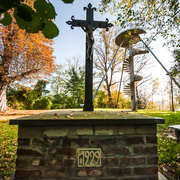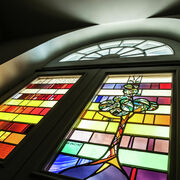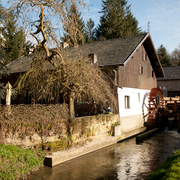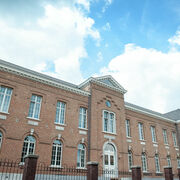Het Bilzers stadhuis
Bilzen Town Hall dates from 1686-1689 and is one of the oldest of its kind in Limburg.
Why does Bilzen Town Hall have a double staircase?
Bilzen once belonged to the Prince-Bishopric of Liège. During the ‘Ancien Régime’ there were two mayors: one elected by the town, and one appointed by the Prince-Bishopric. In order not to compromise their equal status at ceremonies, each mayor had his own staircase to enter the town hall.
Beneath the façade, a small gate gives access to the basement, where there was once a dungeon.
The town hall is home to one of two tourist information offices in Bilzen. Here you can find tourist information, cycling and walking maps, regional products, and gift cards. It is also the meeting point of Jazz Bilzen.
What is that crazy column on the marketplace?
In front of the town hall stands a raised column, known in local slang as ‘het piegelke’. It was a symbol bestowed to all ‘good cities’ by the Prince-Bishopric of Liège.
De Sint-Mauritiuskerk
St. Mauritius Church lies behind the town hall.
The church is named after Saint Maurice, a Roman army commander. You can find his statue in the right aisle. The colours of his uniform – green and red – are the colours of Bilzen.
The present form of the church is a neo-Gothic ‘hall church’. The rich neo-Gothic interior with colourful stained glass windows and modern painting is remarkable and striking.
Borreberg
A castle of the Counts of Loon probably once stood here, perhaps with a watchtower. Destroyed in 1483 and never reconstructed, little is known about what Borreberg Castle looked like.
You can climb to the site via steps from Begijnhofstraat and Brugstraat. Where the castle once stood, there is now a tourist lookout tower offering panoramic views of our town on the Demer and its surroundings.
Wasvrouwtje
Bilzen is the only town in Limburg where the Demer River openly flows through the centre.
Once upon a time there was a bleaching field here, where a washerwoman (wasvrouwtje) sits. The beguines did their washing in the Demer and then laid the clothes on the grass to be ‘bleached’ by the sun. Today, an elegant ‘washerwoman’ still rinses her washing here.
De prieel
This charming building was once the summerhouse of the Grand Commander of Alden Biesen.
You can see the Grand Commander’s coat of arms above Namur stone doorway. Beneath the slated roof there is a beautiful rococo vaulted ceiling inside, richly decorated with stucco panels.
Bilzermolen
This water mill is located in Haffmans Park.
The history of this water mill stretches back to the 13th century, and it has been rebuilt many times. In the second half of the 19th century, the mill was seriously damaged, but the large wheel and the miller’s house were restored.
The water mill is equipped with a fish ladder that allows fish to spawn further upstream in the Demer.
De Wandeling
Why is the old hospital called ‘de wandeling’ (the walk)?
Bilzen once had city walls. Gradually they lost their defensive function and were demolished around 1800. The ramparts first became a walkway around the town – the walk – only accessible to pedestrians.
In 1880, a hospital was built. There were once 150 hospital beds, and later the building was used as a care home.
In modern times.
This listed building has now been fully restored and houses the Kunstkoepel. The old chapel has been converted into a multipurpose hall for exhibitions and concerts.
Huis Petry
The eclectic Petry townhouse – named after its former bourgeois owners – is located in Klokkestraat.
Doctor Gérard François Wéry Van Herckenrode built this beautiful townhouse in around 1865. The initials ‘VH’ on the gable remind us of this.
In 1998, the Petry townhouse was bought by the town of Bilzen. The house was listed as a monument and entirely restored.
Since 2015, the Briers family has been running a gastronomic restaurant, a bed & breakfast, and a bakery there.
The garden is also protected and has been made into a public park named ‘Stadspark Petry’.





